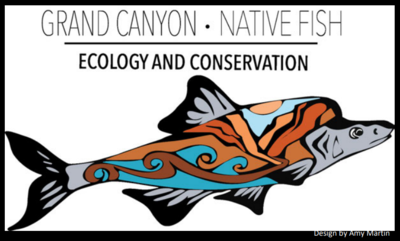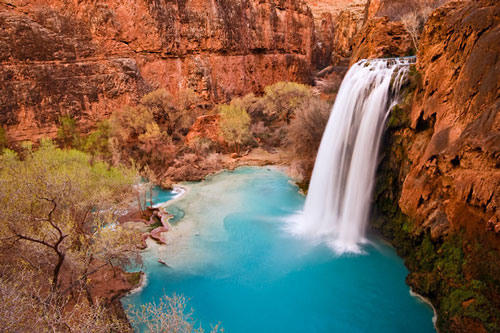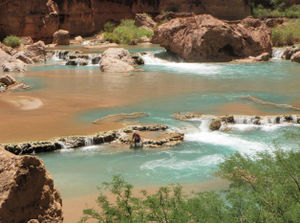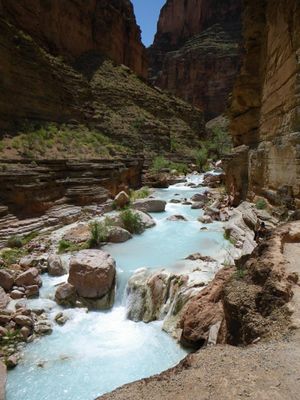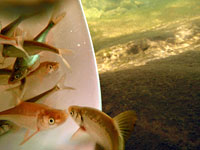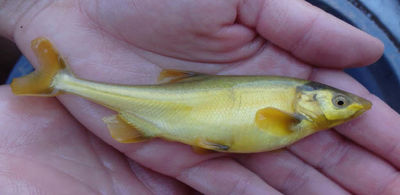Difference between revisions of "Translocation Projects"
Cellsworth (Talk | contribs) |
Cellsworth (Talk | contribs) |
||
| (17 intermediate revisions by the same user not shown) | |||
| Line 17: | Line 17: | ||
</table> | </table> | ||
| − | [[Image:Havasu-Falls-in-Grand-Canyon-41.jpg|thumb|center| | + | [[Image:HumpbackChubAmyMartin.PNG|thumb|center|400px| ]] |
| + | [[Image:Havasu-Falls-in-Grand-Canyon-41.jpg|thumb|center|500px|Havasu Falls]] | ||
<!-- | <!-- | ||
| Line 169: | Line 170: | ||
*In 3-5 years restore native fish community throughout watershed (humpback chub, speckled dace, bluehead sucker) | *In 3-5 years restore native fish community throughout watershed (humpback chub, speckled dace, bluehead sucker) | ||
| − | ==Bright Angel Creek Translocations | + | ==Bright Angel Creek Translocations== |
| + | *[https://www.usbr.gov/uc/rm/amp/amwg/mtgs/18may22/AIF_BA.pdf Translocation of Humpback Chub into Bright Angel Creek: A Joint Project of Grand Canyon National Park, Bureau of Reclamation, and U.S. Fish and Wildlife Service] | ||
| + | *[https://www.researchgate.net/publication/324823294_Review_of_Effective_Suppression_of_Nonnative_Fishes_in_Bright_Angel_Creek_2012-2017_with_Recommendations_for_Humpback_Chub_Translocations Review of Effective Suppression of Nonnative Fishes in Bright Angel Creek, 2012-2017, with Recommendations for Humpback Chub Translocations] | ||
| + | |||
| + | ===Background === | ||
| + | *[https://www.nps.gov/grca/learn/nature/trout-reduction.htm NPS trout reduction] (2012-2017) | ||
| + | |||
| + | ===Objectives === | ||
| + | |||
| + | ===Project History=== | ||
| + | *Translocation (May 2018) | ||
| + | |||
| + | ===Results=== | ||
| + | |||
| + | ===Next Steps=== | ||
| + | *Implementation of an experimental translocation of Humpback Chub with associated monitoring – monitoring will include 2 netting excursions in spring and fall, similar to other NPS-led translocation projects (see Trammell et al. 2012); | ||
| + | *Installation of a PIT tag antenna array at the mouth of Bright Angel Creek to monitor outmigration of translocated Humpback Chub as well as to assist in the assessment of the impacts of monitoring and handling stress on movements of native fishes; | ||
| + | *Implementation of reduced nonnative mechanical removal, including the targeting of areas with high densities of Brown Trout – in 2018, an electrofishing pass may be conducted throughout the stream followed by additional passes in areas with high densities of trout; | ||
| + | *Continued monitoring of the impacts of electrofishing on native fish vital rates (survival, recruitment, etc.) – PIT tagging may be expanded to smaller size classes, as appropriate and in consideration of the health of the fish; and | ||
| + | *Continued consultation with Tribes, consistent with our MOA under Section 106 of the NHPA. | ||
==Beaver Falls Translocations (Havasu Creek) (proposed; 2016 Conservation Measure)== | ==Beaver Falls Translocations (Havasu Creek) (proposed; 2016 Conservation Measure)== | ||
| Line 189: | Line 209: | ||
|style="color:#000;"| | |style="color:#000;"| | ||
| − | |||
*[[Media:2012 HBC Havasu translocation plan.pdf| Implementation and Monitoring Plan for Humpback Chub Translocation to Havasu Creek, Grand Canyon National Park ]] | *[[Media:2012 HBC Havasu translocation plan.pdf| Implementation and Monitoring Plan for Humpback Chub Translocation to Havasu Creek, Grand Canyon National Park ]] | ||
| + | *[http://gcdamp.com/index.php?title=2013_National_Park_Service_Comprehensive_Fisheries_Management_Plan 2013 National Park Service Comprehensive Fisheries Management Plan] | ||
| + | *[https://www.researchgate.net/publication/324823294_Review_of_Effective_Suppression_of_Nonnative_Fishes_in_Bright_Angel_Creek_2012-2017_with_Recommendations_for_Humpback_Chub_Translocations Review of Effective Suppression of Nonnative Fishes in Bright Angel Creek, 2012-2017, with Recommendations for Humpback Chub Translocations] | ||
|- | |- | ||
| Line 196: | Line 217: | ||
|- | |- | ||
|style="color:#000;"| | |style="color:#000;"| | ||
| + | |||
| + | '''2022''' | ||
| + | *[https://www.usbr.gov/uc/progact/amp/twg/2022-01-13-twg-meeting/20220113-AnnualReportingMeeting-HumpbackChubTributaryTranslocationMonitoring-508-UCRO.pdf Humpback Chub Tributary Translocation Monitoring] | ||
| + | |||
| + | '''2021''' | ||
| + | *[https://doi.org/10.1111/1365-2664.13908 Yackulic et al. 2021. Assessing the population impacts and cost-effectiveness of a conservation translocation: Journal of Applied Ecology] | ||
| + | *[https://www.usbr.gov/uc/progact/amp/twg/2021-01-22-twg-meeting/20210122-AnnualReportingMeeting-DriversDemographicRatesTranslocatedHumpbackChubPopulationsAnnualUpdate-508-UCRO.pdf Drivers of Demographic Rates in Translocated Humpback Chub Populations and an Annual Update ] | ||
| + | |||
| + | '''2020''' | ||
| + | *[[Media:2020 NPS 2020 Chub Translocation Activities Final Report final.pdf| NPS 2020 Chub Translocation Activities Final Report ]] | ||
| + | *[https://gcc02.safelinks.protection.outlook.com/?url=https%3A%2F%2Fdoi.org%2F10.1002%2Fnafm.10425&data=02%7C01%7C%7Cbbeb7e87c1ae4f3e60ac08d7dd777fc7%7C31ae220fb94f463a9cfd15bbc9909df5%7C0%7C0%7C637221377637163405&sdata=4fZ77zeyhiTJH3zHHnvNPpPR3r0Hr6%2Fawwgi5X17B1Q%3D&reserved=0 Stone et al. 2020. Effects of disparate water temperatures and food bases on Humpback Chub growth rates within the Little Colorado River, Arizona. North American Journal of Fisheries Management] | ||
| + | |||
| + | '''2019''' | ||
| + | *[https://afspubs.onlinelibrary.wiley.com/doi/epdf/10.1002/nafm.10408 Healy et al. 2019. Establishment of a reproducing population of endangered Humpback Chub Gila cypha through translocations to a Colorado River tributary in Grand Canyon, Arizona. AFS] | ||
| + | *[[Media:NPS trip report Shinumo September2019 24Sept2019 (1).pdf| Shinumo Creek, Shinumo inflow, and invasive species surveillance monitoring, September 3 – 12, 2019 Trip Report]] | ||
| + | *[[Media:NPS 2018 BrightAngel translocation TripReport May2019.pdf| NPS fisheries trip report - Bright Angel Creek 2018 translocation]] | ||
| + | *[https://www.usbr.gov/uc/progact/amp/twg/2019-03-14-twg-meeting/20190314-EfficacyHumpbackChubTranslocationsInvasiveTroutControlGrandCanyonTributaries2012-2018-Presentation-508-UCRO.pdf Efficacy of Humpback Chub translocations and invasive Trout control in Grand Canyon tributaries, 2012-2018] | ||
'''2018''' | '''2018''' | ||
| + | *[https://www.usbr.gov/uc/rm/amp/amwg/mtgs/18may22/Attach_05.pdf AIF: Translocation of Humpback Chub into Bright Angel Creek: A Joint Project of Grand Canyon National Park, Bureau of Reclamation and U.S. Fish and Wildlife Service PPT] | ||
*[https://www.usbr.gov/uc/rm/amp/twg/mtgs/18apr23/Attach_08.pdf Bright Angel Brown Trout Removal and Humpback Chub Translocations] | *[https://www.usbr.gov/uc/rm/amp/twg/mtgs/18apr23/Attach_08.pdf Bright Angel Brown Trout Removal and Humpback Chub Translocations] | ||
| Line 234: | Line 273: | ||
|- | |- | ||
|style="color:#000;"| | |style="color:#000;"| | ||
| + | |||
| + | ==At what flow does the Shinumo Falls reconnect?== | ||
| + | The Shinumo Creek barrier falls begins to be connected to the mainstream at a flow of about 60,000 cfs, based on observations there in 1983. That flow does not overtop the barrier, but opens a jump-up passage. It takes about 100,000 cfs to overtop the whole falls. --Larry Stevens | ||
[[Image:GoldenChub.jpg|thumb|left|400px|The Golden Chub: the finder of this fish gets a prize]] <br> | [[Image:GoldenChub.jpg|thumb|left|400px|The Golden Chub: the finder of this fish gets a prize]] <br> | ||
Latest revision as of 13:47, 15 April 2022
|
|
LTEMP BiOp Conservation Measures for Humpback Chub Conservation (2016)Reclamation would continue to support the NPS, FWS, GCMRC, and GCDAMP in funding and implementing translocations of humpback chub into tributaries of the Colorado River in Marble and Grand Canyons, and in monitoring the results of these translocations, consistent with agencies’ plans and guidance (e.g., NPS Comprehensive Fisheries Management Plan [CFMP], FWS Humpback Chub Genetics Management Plan and Translocation Framework, and GCMRC Triennial Work Plan). Translocations allow for opportunities to expand the area occupied by humpback chub and improve the overall status of the species. Specifically, the following would occur:
|
| -- |
-- |
-- |
|---|
|
|
